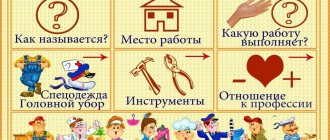Speech therapy lesson summary: Work on distributing proposals on the topic “Transport”
Speech therapy session summary
Presentation for the lesson PPTX / 2.59 MB /data/files/w1636564283.pptx (Presentation for the lesson) Topic: Working on disseminating proposals on the topic “Transport”
Class:
4
Target:
developing the skill of composing a common sentence using pictures and supporting words
.
Tasks:
-clarify and expand the vocabulary on the topic “Transport”;
- improve the grammatical structure of speech;
- develop coherent speech, auditory attention, phonemic perception, thinking, visual, figurative memory, fine motor skills;
- develop dialogic speech, speech breathing, articulatory apparatus;
- cultivate love and interest in writing;
— develop cooperation skills: the ability to work in a team;
- to unite the children's team, to show the importance of each student in the unified work of the class
Technologies:
games, health-saving (finger exercises, breathing exercises).
Equipment:
PC, presentation “Composing common sentences”, pens, notebooks, sets of words, individual mirrors, laces, silhouette pictures, evaluative emoticons.
Progress of the lesson:
1. Organizational moment.
We will sit in a circle together, we need to say hello. I tell you: “Hello!” Smile back quickly. Hello right hand, Hello left hand, Hello friend, hello friend, Hello our entire friendly circle.
Guys, look, we have guests today. Let's smile at our guests!
Updating knowledge, creating a problem and ways to solve it
Guys, I want to show you a letter. Previously, people wrote letters to each other, put them in an envelope and took them to the post office. From there, letters were sent to the addressee by various means of transport. During the summer holidays, my son corresponded with a friend from another city. One day, he received a letter in which some words were not visible. Maybe the erasable pen failed...
Let's read this letter.
Hello, my friend!
Now you can’t go to theaters and cinema, but you can attend interesting events while looking at a computer monitor. Yesterday I visited an unusual transport exhibition.
I've seen different models. —— ——-
sailed
-
a motor ship.
——-
the bus passed by
——- ———
.
At any time of the day, transport was in motion. ——
the plane was flying
———.
——— the train was rushing
—— ——.
I'm delighted with the models I saw! I want to visit the exhibition again.
Do you understand the meaning? Are those sentences where the words have been erased beautiful? Why? Have you guessed what we will do in class? (restore sentences, add words to sentences, distribute sentences)
What topic did the friend touch on in the letter? What are we going to talk about? (transport)
What kind of ground transport do you know? What about air? What about water?
Articulation gymnastics
To speak well and pronounce everything clearly, let’s train our tongues and lips. Let's imagine that our tongue is a car that was parked in the garage and then drove out.
“Fence”, “Smile” - the car is standing in the garage, the gate is closed and... opened, the tongue-shaped car drives out; “Watch” - the car goes right, left (at the top); “Swing” - the car went up the mountain and slid down the mountain; “Shovel” - the car has stopped, we rest; and went to the “Chasiki” garage - left, right (below) and drove into the garage and hid the tongue in my mouth.
Discovery of new knowledge
Now we have arrived at our first task, what do we see? ( Simple sentences)
Here's a look at what words remain from our story. What can be formed from these words? (simple sentences)
The ship was sailing.
The bus was passing.
The plane was flying.
The train was rushing.
Let's add words to our sentences and make them more beautiful. Do you know what types of ships, planes and trains there are? Let's make up phrases.
Assignment: make up word combinations from words and write them down in a notebook. The words written on the cards are distributed to the students.
Fast motor ship
Intercity bus
Scheduled airplane
Express train
Working with a proposal
Assignment: you need to insert phrases into sentences and write them down.
A high-speed motor ship was sailing.
An intercity bus was passing by.
A regular plane was flying.
A fast train was rushing by.
Fizminutka
Guys, let's play and remember the different types of transport. Now I will name the transport for you, and you will imitate it (air transport - you imitate the wind - you blow, ground transport - you stomp, water transport - you make the movements of a swimmer.
Development of fine motor skills and orientation on the sheet
Assignment: you need to lay out the outline of a car, ship, plane, bus, etc. from a lace. If this is difficult, then you can work with transport silhouettes. Place the string around the transport office.
Working with a proposal.
Spreading a proposal using a picture.
Assignment: you need to complete the sentence with a word-picture. Write down the suggestions in your notebook.
Pictures: river, mountains, night, train
A high-speed motor ship was sailing along the river.
The intercity bus drove past the mountains.
The airliner was flying at night.
The fast train was rushing to Moscow.
Bottom line
Let's now compare what the sentences were and what they became after we added their words. Guys, how have the offers changed?
Now let's listen to what the letter turned out to be.
Additional task
Let's try to make some more sentences. Children are given words from which they need to make sentences.
The postal vehicle delivered the parcels to the post office. The valuable letter was sent by air.
Reflection
Guys, take a sticker and stick it in your notebook “bus” if the topic of the lesson is clear to you, “car” if you still have questions about the topic
III period of study Lesson No. 6
Topic: Spreading sentences by introducing homogeneous definitions:
Goals: To teach children to select as many definitions as possible for a subject or object. Include attribute words in a certain place in the sentence before the word being defined. Expand and activate children's vocabulary. Clarify the concepts of “word”, “sentence”, “action”.
Progress of the lesson
Organizing time. The one who completes the task sits down
speech therapist (the speech therapist sets the task in accordance with the topic of the lesson).
1. The speech therapist asks the children a riddle:
,-. They beat him, but he doesn’t cry, he just jumps more cheerfully. They play volleyball with them, they will score a goal against them.
The children guess the riddle and the speech therapist takes out a large beautiful ball from under the table. After examining the ball, the speech therapist asks: “What color is the ball? What shape? What is the largest? What kind of material?” (These questions were worked on in previous lessons.)
After selecting definitions (multi-colored, round, big, rubber), with the help of prompting gestures from a speech therapist and naming antonym words, children pronounce the following definitions: beautiful, shiny, elastic, light, new, etc.
When naming each of these definitions, the speech therapist places red rectangles on the typesetting board according to the number of selected words. Then he says to the guys: “You and I have chosen a lot of words about what
It’s an object.”
2. The speech therapist leaves five rectangles on the typesetting canvas and takes out a box from under the table, while reading the poem:
There are items here in the box.
Everyone will now get theirs..
Examine the object, touch it
And think about it - what is he like?
The speech therapist gives the children objects that can be easily identified by color, shape, size, and what material they are made of, and asks the children to talk about these characteristics of the objects.
Then he points to five red rectangles and says that you need to come up with five words about what
item.
Children, looking at the chips, control the number of words they choose. The speech therapist interviews four or five children.
3. The speech therapist puts a picture in front of the children. It depicts a girl carrying a large multi-colored ball, similar to the one the children looked at at the beginning of the lesson. Then the speech therapist asks you to make a three-word sentence based on this picture. (The girl carries the ball.)
The speech therapist records the number of words named on a typesetting canvas with squares of a different color (for example, blue) and tells the children: “Now I will turn a short sentence into a long, beautiful, interesting one.”
Then he moves the last blue square to the right and slowly pronounces a sentence with five or six definitions. For example: “The girl is carrying a red, big, beautiful, new, shiny, rubber ball.” It is necessary to focus children's attention on the fact that the word ball
appeared at
the end of the sentence.
4. Dynamic science.
The speech therapist asks the children to include their four definitions in the same sentence, stand up, go to the typesetting canvas and display each word on the diagram.
Other sentences are distributed similarly (for example: “The boy is holding a flag”, “The girl is watering the flower”).
5. The speech therapist puts in front of the children a picture in which a girl is drawn carrying some object (its image is covered with a white sheet of paper). The speech therapist says: “Let's imagine that the girl is carrying your object
(referring to the items distributed to the children at the beginning of the lesson). What short sentence will you make?”
After the task is completed, the speech therapist says: “Now make up a long
a sentence with four words about
what
your subject is.” (The speech therapist points to the diagram.)
The guys make up long sentences. The speech therapist makes sure that the word being defined is at the end of the sentence and the children correlate the spoken words with their display on the diagram.
In conclusion, the speech therapist opens the object that is closed in the picture and short and long sentences are composed for it.
6. The lesson is summed up and the children’s answers are assessed.


